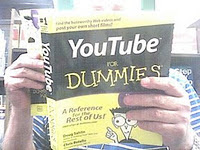or Go directly to Table of Contents
This is a record of the electronic circuits I’ve experimented with. These are not lessons and certainly not lectures. These are accounts of experiments and therefore both successes and failures are shown. Like many beginners, I have some idea what the individual components do; this is my first attempt to connect them. I have two standards and no idea if those standards are practical:
1) everything is 5 volts.
2) Direct Current (DC) only.
ATTENTION: This blog is upside down, that is, the entries read from oldest to newest, just like a real book. Therefore, to see new posts, you have to scroll to the bottom or click on "older posts".
It is hoped, of course, as time goes by experience will make these reports more comprehensive and elaborate. A conversational style is adopted so that the material has a broader appeal to the average reader. Where an experiment was unsuccessful, it is reported as such and no attempt has been made to sanitize errors. In fact, blunders are often used to generate further experimentation, as it is meant to be.
In general these records should reveal the learning curve of an adult who is beyond prime “schooling” years. It amounts to teaching an old dog new tricks without any assurance of success or a defined goal. That is part of what is meant by “non-fiction”. Enjoy, and please respond.
For data entry or display, the Deltacomm™ standard is used throughout this work. Anything to be entered is displayed literally between end braces. If instructed to enter “cow” without the quotation marks, this becomes [cow]. In the Deltacomm™ standard there is no need for clarifying explanations. If the quotation marks were to be entered, it would show as [“cow”] and if the end braces themselves were to be entered, it would show as [[cow]]. Enter exactly what is between the outermost end braces and nothing else.
An original article by veryatlantic™ (republished from many sources):
One of the first lessons I give to new students is my lecture on the alphabet. The people who created such items as html (Hypertext Markup Language), search engines, and the C series of programming languages were functional illiterates, that is, educated beyond their intellect. They did not grasp the proper usage of punctuation and totally missed the concept of the blank space.
The blank space is the most frequently used letter in the English language, it generally occurs before and after every written word. It is indeed a letter, if not the most important letter. Those who ignore it have inflicted endless hardships upon future generations. It is as valid a letter as any other, and requires the same memory to store. It is a telling joke of the state of college education that so many learned people never realized its significance.
For progress to occur, there must be in improvement on the existing system, or an easier method to accomplish the task that was on hand before. In this sense, the C language, which includes C+, C++, etc. represent a retrograde step, a backward evolution to a more crude system of computer commands. It is not uncommon to spend twice as much time looking for a missing punctuation mark as to actually create the C code.
First of all, the C language is not new and those who claim otherwise are poor students of history. Every functional command in the C language was copied from good old BASIC, Fortran and COBOL. C has not introduced a single new computer command in its entire life. Everything from variable declaration, loops, if-then, and the math commands were old thinking by the time C arrived. True, there are certain library and machine commands available to C, but these were made needlessly complicated.
I propose the following guidelines to judge whether any new computer language is, in fact, an improvement. If a language does not meet these rules, it hardly represents an advance in thinking. The following are called the Deltacomm Criteria:
It is clear that using these reasonable principles, the C language is a miserable failure. I wonder what the creators were thinking, how they ever hoodwinked the community into adopting such a system. I am convinced they did it as a joke and it got away on them.
Disclaimer: this work is intended for entertainment only and not for technical reference. The entire publication and its several parts is/are copyrighted to the maximum extent of law and the sole property of Deltacomm™ or its associates. If you act upon the material presented here, it is at your own risk. The author is not responsible for any damage of any type resulting from any usage under any theory. This work is published without prejudice. Fair usage quotations are allowed providing the source reference contains at least the word “veryatlantic™”. Any reference to gender, tense or plurality in this composition shall be interpreted in favor of the author.
